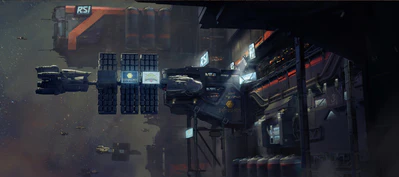Quick facts:Hull D
The MISC Hull D (UEE Military Starlift Command call-sign R4M Quasar[1]) kicks off the larger end of the spectrum with a massive ship built around a rugged frame. The Hull D is affordable enough to be operated by mid-sized organizations and companies. They are often used as flagships for mercantile operations, but their bulk means that they should be operated with escorts when not in secure space. The UEE military uses modified versions of the Hull D, known as R4M Quasar, as the backbone of their supply chain.[2]
The Hull D cargo capacity is 648 32-SCU containers at full load. They are the minimum-equippable sized container for the RAFT, Hull C, Hull D and Hull E.[3]
Description
Model D of the MISC cargo Hull series is the powerhouse of freighter ingenuity. This fourth iteration features a wide range of cargo configurations, making it the ideal ship for hauling large cargo to your destination. With massive engines and hearty defences, the Hull D will get you to your delivery point on time and intact.
Specifications
| Systems | ||||
|---|---|---|---|---|
| Component | Manufacturer | Model | Size (Max) | # per mount x total |
| TBD | C Power Plant | Capital (Capital) | 1 x 1 | |
| TBD | C Cooler | Capital (Capital) | 1 x 2 | |
| TBD | C Shield Generator | Capital (Capital) | 1 x 2 | |
| Propulsion | ||||
|---|---|---|---|---|
| Component | Manufacturer | Model | Size (Max) | # per mount x Total |
| TBD | C Fuel Intake | Capital (Capital) | 1 x 2 | |
| C Fuel Tank | Capital (Capital) | 1 x 2 | ||
| C Quantum Drive | Capital (Capital) | 1 x 1 | ||
| TBD | C Jump Module | Capital (Capital) | 1 x 1 | |
| C Quantum Fuel Tank | Capital (Capital) | 1 x 1 | ||
| Weaponry | |||||
|---|---|---|---|---|---|
| Component | Manufacturer | Model | Details | Size (Max) | # per mount x Total |
| TBD | Weapon TBC | TBD () | x 1 | ||
| TBD | Weapon TBC | Remote | TBD (4) | 2 x 1 | |
| TBD | Weapon TBC | Remote | TBD (3) | 2 x 3 | |
| TBD | TBD | TBD () | x 1 | ||
Testimonial
“I started my career as hull gunner on an R4M Quasar [the military conversion of the MISC Hull D] and went on to command a lifter crew for nine years while supporting border actions and anti-piracy patrols. Got into more scrapes than I can count, shot up a dozen raiders and never lost a pallet. The fighter and bomber pilots I went to officer training with may get in the history books, but they wouldn’t be effective without the supply chain we provided. Not that there was a competition: I’ll tell you this, those boys on the front lines always make it easy… our fighter screen would raise hell to make sure the weekly mail drop came through.”
- Colonel Yurg Cathonshew, UEE Military Starlift Command
Series variants
For most of the concern’s history, the majority of MISC’s business has come from the production output of its heavy industrial division. MISC-HI is chiefly responsible for the Hull series range of configurable bulk transport spacecraft that have become ubiquitous in UEE space. These sturdy, modular hulls are the basis for the majority of Human corporate shipping. Their unexpected popularity among the Xi'an has spawned an unlikely business relationship (and a string of imitators on the other side of the border).
When the line launched in 2802, four standard models ranged in size from the efficient Hull A to the gargantuan Hull D. The Hull series quickly revolutionized interstellar freight, leading to the standardization of dockyards and cargo processes around the UEE. This led to long-ranging knock-on effects, including over a dozen outside companies being founded or significantly shifting focus to support the Hull design, such as Argo Astronautics launching its MPUV line of short-range cargo ferries. In 2820, MISC developed a fifth ‘super-freighter’, the Hull E, which has since become the de facto interplanetary bulk goods transporter, with docks around the galaxy moving cargo containers back and forth from the huge ships around the clock[4]
| Image | Name | Description |
|---|---|---|
 |
Hull A | The smallest, most affordable Hull. The Hull A is great for those just striking out in the galaxy on their own. |
 |
Hull B | The Hull B is a more rugged option most often compared to MISC’s own Freelancer. But where the Freelancer is equipped for long range exploration and other roles, the Hull B is a pure cargo transport. |
 |
Hull C | The middle ground between single-person transporters and massive super-freighters |
 |
Hull E | The ultimate edition of the Hull series. A ship is one of the largest player owned ships in the game and is so massive, it requires proper planning and preparation for the trips it will make. |
Trivia
- With a nominal load of 648 32-SCU containers, a Hull-D has a similar carrying capacity as a modern Feeder cargo container ship. A 32-SCU containers is roughly equivalent to a 40-foot container (FEU)[5] and Feeder container-ships carry between 500 and 1,400 FEU.[6]
Gallery
See also
References
- ↑ Q&A: MISC Hull D. Engineering - Comm-Link
- ↑ Hull D Store page. Pledge Store
- ↑ Q&A Argo RAFT. Engineering - Comm-Link. Retrieved 2021-11-25
- ↑ "Manufacturer feature: MISC". Jump Point. Vol. 10 no. 4. pp.18. Retrieved 2022-12-12.
- ↑ LIS: Logistics & Transport Lexicon - ISO-Container
- ↑ MAN Diesel (2009). "Propulsion Trends in Container Vessels" (PDF). Copenhagen: MAN Diesel. Archived from the original (PDF) on 2012-05-07. Retrieved 2011-12-29.





